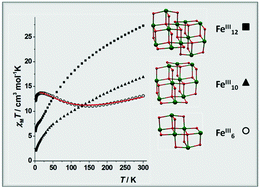Binding of ligands containing carbonyl and phenol groups to iron(iii): new Fe6, Fe10 and Fe12 coordination clusters†
Abstract
The initial use of ligands 2′-hydroxyacetophenone (HL1), 2-hydroxybenzophenone (HL2) and 2,2′-dihydroxybenzophenone (H2L3) in iron(III) chemistry is described. The syntheses and crystal structures are reported for five iron(III) clusters: [Fe10O4(OMe)14(L1)6(MeOH)2](NO3)2·3MeOH (1·3MeOH), [Fe12O4(OH)(OMe)17(L1)8](ClO4)2·2H2O (2·2H2O), [Fe10O4(OMe)14Cl4(L2)4(MeOH)2] (3), [Fe10O4(OMe)14(L2)6(py)2](ClO4)2·MeOH (4·MeOH), where py = pyridine, and [Fe6O2(OEt)6(O2CMe)2(L3)2(HL3)2] (5). The molecular structures of the decanuclear clusters 1, 3 and 4 are organized around a {Fe10(μ4-O)4(μ3-OMe)2(μ-OMe)12}8+ core consisting of ten {Fe3O4} face-sharing defective cubane units. The core of 2 consists of a {Fe12(μ4-O)4(μ3-OMe)4(μ-OH)(μ-OMe)13}10+ unit composed of twelve {Fe3O4} face-sharing defective cubanes. The ligands (L1)− and (L2)− in 1–4 adopt the O,O′-bidentate chelating coordination mode and their roles are to terminate the further aggregation of the FeIII/O2−/RO− cores. Complex 5 contains the {Fe6(μ4-O)2(μ-OEt)6(μ-Ocarbonyl)2}4+ core, where the μ-Ocarbonyl atoms are the bridging carbonyl oxygens of the two η1:η2:η1:μ (L3)2− ligands; the (HL3)− groups behave as Ophenolate, Ocarbonyl-bidentate chelating ligands with the neutral hydroxyl group being unbound to the FeIII atoms. The core is composed of four {Fe3O4} face-sharing defective cubanes. The FeIII atoms in 1–5 are all six-coordinate with distorted octahedral geometries. The IR spectra of the complexes are discussed in terms of the known coordination modes of the ligands and the ionic character of nitrates and perchlorates. Variable-temperature magnetic susceptibility and variable-field magnetization measurements establish that 2, 3 and 5 have S = 3, 0 and 5 ground states, respectively. The susceptibility data for 5 were fitted using a 3-J model indicating the simultaneous presence of both antiferromagnetic and ferromagnetic FeIII⋯FeIII exchange interactions. Known magnetostructural correlations in oxido-bridged iron(III) systems have been applied to rationalise the magnetic behaviour of the three clusters. The results of the present study demonstrate the utility of HL1, HL2 and H2L3 in the stabilisation of robust iron(III)/oxido/alkoxido clusters.



 Please wait while we load your content...
Please wait while we load your content...